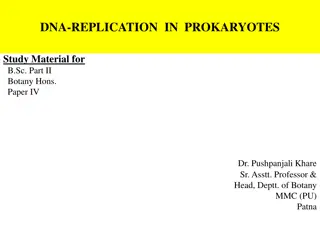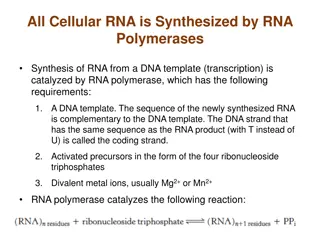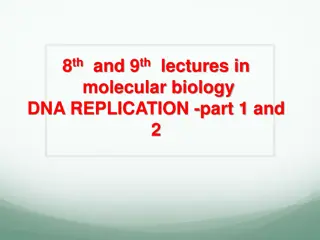Understanding DNA Replication and Genetic Transcription
Explore the fundamental concepts of molecular biology focusing on DNA replication, transcription of genetic material into mRNA, and translation into functional proteins. Learn about the semiconservative nature of Eukaryotic DNA replication, the proteins involved, steps in the replication process, and the overall direction of replication. Enhance your knowledge of the essential processes that drive cellular functions.
Download Presentation

Please find below an Image/Link to download the presentation.
The content on the website is provided AS IS for your information and personal use only. It may not be sold, licensed, or shared on other websites without obtaining consent from the author. Download presentation by click this link. If you encounter any issues during the download, it is possible that the publisher has removed the file from their server.
E N D
Presentation Transcript
Molecular biology (2) (Foundation Block)
Objectives By the end of this lecture, the students should be able to: To understand DNA replication To know the transcription of genetic material into messenger RNA To get an idea about the translation of mRNA into a functional protein.
DNA is the genetic material Therefore it must: 1. Replicate faithfully. 1. Have the coding ability to produce proteins for all cellular functions.
Features of Eukaryotic DNA Replication Semiconservative with respect to parental strand: Daughter DNA molecules contain one parental strand and one newly-replicated strand. Bidirectional with multiple origins of replication. Origin 3 5 5 3
Primed by short stretches of RNA. Semi-discontinous Semidiscontinuous DNA replication. In DNA replication, both daughter strands (leading strand red, lagging strand blue) are synthesized in their 5 3 directions
Proteins involved in DNA Replication DNA Helicase. Single-stranded DNA binding proteins. DNA Primase. DNA polymerases (5 types: ; ; ; ; ). DNA ligase. Topoisomerases: Topoisomerase I. Topoisomerase II. Telomerases
Steps in DNA Replication 3 3 5 5 3 5 3 5 Helicase protein binds to DNA sequences called origins and unwinds DNA strands. Single-Stranded binding proteins prevent single strands from rewinding. Primase protein makes a short segment of RNA primer complementary to the DNA.
Overall direction of replication 3 3 5 5 3 5 3 5 DNA polymerase: Adds DNA nucleotides to the RNA primer. Proofreads bases added and replaces incorrect nucleotides
Overall direction of replication 3 3 5 5 3 Okazaki fragment 5 3 5 3 5 Leading strand synthesis continues in a 5 to 3 direction. Discontinuous synthesis produces 5 to 3 DNA segments (Okazaki fragments).
3 3 5 3 5 3 5 3 5 5 Exonuclease activity of DNA polymerase removes RNA primers
3 3 5 3 5 3 3 5 5 DNA polymerase fills the gaps. Ligase forms bonds between sugar-phosphate backbone
The central dogma of Molecular Biology A portion of DNA, called a gene, is transcribed into RNA. RNA is translated into proteins.
Transcription (mRNA synthesis) A portion of DNA (a gene) is transcribed into messenger RNA (mRNA). Only one of the DNA strands is transcribed (antisense strand). The RNA polymerase II is responsible for this process. The direction of transcription is 5 3 .
Steps of mRNA synthesis Chain initiation: RNA polymerase II binds to promoter region of DNA to start transcription.
Steps of mRNA synthesis Chain elongation: A portion of DNA template unwinds (opens) at the point of RNA synthesis. This forms a short length of RNA-DNA hybrid. Chain termination: DNA contains specific sites which stop transcription (at a sequence of 4-10 AT base pairs).
Post-transcriptional modification Capping: Addition of a methylated guanine nucleotide at 5 end of mRNA Function: To prevent mRNA degradation by exonucleases. It helps the transcript bind to the ribosome during protein synthesis. Polyadenylation: Addition of a poly(A) tail (a highly conserved AAUAA sequence) at 3 end of mRNA. Functions: To protect the mRNA from degradation For ribosomal RNA recognition Intron removal for releasing mature mRNA from nucleus.
The central dogma of Molecular Biology A portion of DNA, called a gene, is transcribed into RNA. RNA is translated into proteins.
Translation (Protein synthesis) A process of protein synthesis from mRNA mRNA has genetic codes for amino acids present in proteins. The genetic code is a dictionary that identifies the correspondence between a sequence of nucleotide bases and a sequence of amino acids. Each individual word in the code is composed of three nucleotide bases (codons).
64 possible codons: 61 codons specify 20 amino acids One start codon (AUG) 3 stop codons UAA, UAG and UGA
Components required for Translation Amino acids. Transfer RNA (tRNA). Aminoacyl-tRNA synthetases. mRNA. Functionally competent ribosomes. Protein factors. ATP and GTP.
Take home messages DNA is the genetic material, so it must replicate faithfully and have the coding ability to produce proteins for all cellular functions. Only one strand of DNA (antisense strand) is transcribed into mRNA. The synthesized mRNA is protected from the destruction and prepared for translation through post-transcriptional modification. mRNA transcription and protein synthesis processes are the same in both prokaryotic eukaryotic cells with some differences.
References Lippincott s Illustrated reviews: Biochemistry 6th edition, Unit 6, chapters 29, 30 and 31, Pages 395-448. Lippincott s Illustrated reviews: Cell and Molecular Biology, Unit 2, Chapters 7, 8 and 9, Pages 69-106.























